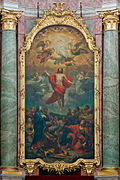| Dresden Cathedral | |
|---|---|
| The Cathedral of the Holy Trinity | |
| The Catholic Church of the Royal Court of Saxony | |
 Katholische Hofkirche, 2023 | |
 | |
| 51°03′13″N13°44′15″E / 51.05361°N 13.73750°E | |
| Location | Dresden |
| Country | Germany |
| Denomination | Catholic Church |
| Sui iuris church | Latin Church |
| History | |
| Status | Active |
| Founded | 1739 |
| Founder(s) | Augustus III of Poland |
| Consecrated | 29 June 1751 |
| Architecture | |
| Functional status | Cathedral |
| Architect(s) | Gaetano Chiaveri |
| Completed | 1751 |
| Administration | |
| Province | Berlin |
| Diocese | Dresden-Meissen |
| Clergy | |
| Bishop(s) | Heiner Koch |
Dresden Cathedral, or the Cathedral of the Holy Trinity, Dresden, previously the Catholic Church of the Royal Court of Saxony, called in German Katholische Hofkirche and since 1980 also known as Kathedrale Sanctissimae Trinitatis, is the Catholic Cathedral of Dresden.
Contents
Always the most important Catholic church of the city, it was elevated to the status of cathedral of the Diocese of Dresden–Meissen in 1964. It is located near the Elbe river in the historic center of Dresden, Germany.
It is one of the burial sites of the House of Wettin, including Polish monarchs.













